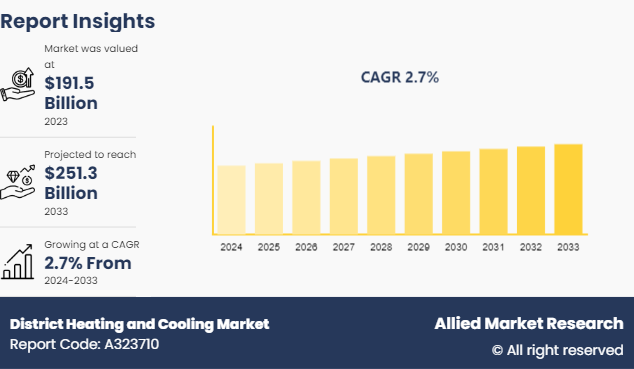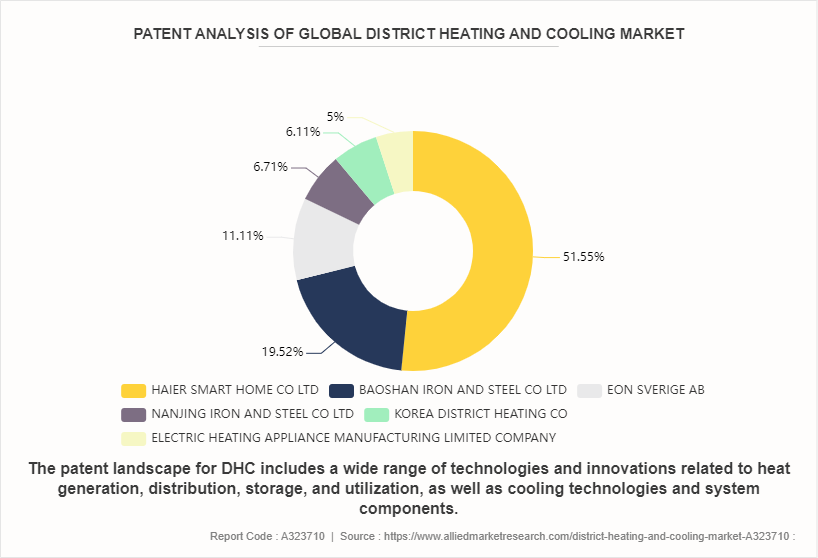District Heating And Cooling Market Research, 2033
The global district heating and cooling market was valued at $191.5 billion in 2023, and is projected to reach $251.3 billion by 2033, growing at a CAGR of 2.7% from 2024 to 2033.

Market Introduction and Definition
District heating and cooling (DHC) is a centralized energy distribution system that provides heating and/or cooling to multiple buildings or facilities within a defined geographic area, typically an urban or suburban district. In a district heating system, heat is generated centrally at a central plant, often through the combustion of fossil fuels, biomass, or by harnessing renewable energy sources such as geothermal energy or waste heat from industrial processes. District heating and cooling systems offer several advantages over decentralized heating and cooling solutions. They achieve economies of scale by centralizing energy production, leading to lower operating costs, increased energy efficiency, and reduced environmental impact compared to individual heating and cooling systems. In addition, DHC systems enable the utilization of waste heat from various sources, improving overall energy efficiency and reducing greenhouse gas emissions.
Key Takeaways
The report provides competitive dynamics by evaluating business segments, product portfolios, target market revenue, geographical presence, and key strategic developments by prominent manufacturers.
The district heating and cooling market is fragmented in nature among prominent companies such as Prysmian Group, ZTT International, Fujikura Cable Corporation, Winfoc, and Furukawa Electric Co., Ltd., Elsewedy Electric, Sumitomo Electric Industries Ltd., LS Cable & System, Sterlite Technologies Ltd., and Bancor.
The study contains qualitative information such as the market dynamics (drivers, restraints, challenges, and opportunities) , public policy analysis, pricing analysis, and Porter’s Five Force Analysis across North America, Europe, Asia-Pacific, LAMEA regions.
Latest trends in global district heating and cooling market such as undergoing R&D activities, regulatory guidelines, and government initiatives are analyzed across 16 countries in 4 different regions.?
More than 2, 200 district heating and cooling-related product literatures, industry releases, annual reports, and other such documents of key industry participants along with authentic industry journals and government websites have been reviewed for generating high-value industry insights for global district heating and cooling market.
Key Market Dynamics
District heating and cooling (DHC) systems offer a more environmentally friendly alternative to conventional heating and cooling methods. They utilize waste heat from various sources such as industrial processes, power generation, and renewable energy systems, reducing greenhouse gas emissions and overall energy consumption. As the world becomes increasingly aware of climate change and the need to mitigate its effects, the demand for sustainable heating and cooling solutions continues to rise, thus driving the growth of the DHC market.
Furthermore, DHC systems are inherently more efficient than individual heating and cooling units, as they allow centralized energy production and distribution. By capturing and utilizing waste heat that would otherwise be lost, DHC systems achieve higher levels of energy efficiency, resulting in lower energy costs for consumers and reduced strain on energy resources. The pursuit of energy efficiency targets by governments and businesses worldwide further incentivizes the adoption of DHC systems, thus fueling market growth.
In addition, rapid urbanization witnessed across the globe has led to increased energy demand in densely populated areas. For instance, according to a report published by International Energy Agency in 2023, the global electricity demand rose by 2.3% in 2023. District heating and cooling systems are particularly well-suited for urban environments, where the concentration of buildings enables cost-effective implementation and efficient heat exchange. Moreover, as urban population continues to grow, the need for reliable and scalable heating and cooling solutions becomes more pronounced, driving the expansion of the DHC market.
However, one of the primary restraints of DHC systems is the high upfront investment required for infrastructure development. Building the necessary networks of pipes, pumps, and heat exchange facilities is costly, especially in densely populated urban areas with existing infrastructure. Moreover, the complexity of designing and implementing DHC systems adds further to the costs and requires coordination among multiple stakeholders, including utilities, local governments, and property developers.
On the contrary, the district heating and cooling market offers a multitude of opportunities for stakeholders to innovate, collaborate, and drive sustainable growth. DHC systems play a pivotal role in addressing climate change, promoting economic development, and enhancing energy security by leveraging renewable energy, waste heat utilization, energy efficiency improvements, and smart city integration. These factors are expected to create remunerative opportunities for the district heating and cooling market during the forecast period.

Patents in this space cover aspects such as heat exchangers, thermal energy storage systems, control systems, and integration with renewable energy sources. Key patent holders in the district heating and cooling market include companies such as HAIER SMART HOME CO LTD, BAOSHAN IRON AND STEEL CO LTD, EON SVERIGE AB, NANJING IRON AND STEEL CO LTD, KOREA DISTRICT HEATING CO, and ELECTRIC HEATING APPLIANCE MANUFACTURING LIMITED COMPANY IN JIUYI DISTRICT OF FOSHAN CITY that hold significant patent portfolios covering various aspects of district heating and cooling systems.
Market Segmentation
The district heating and cooling market is segmented into heat source, application, and region. By heat source, the market is divided into coal, natural gas, renewables, oil & petroleum products, and others. As per application, the market is categorized into residential, commercial, and industrial. Region-wise the market is analyzed across North America, Europe, Asia-Pacific, and LAMEA.
Competitive Analysis
The major players operating in the district heating and cooling market include Fortum, Vattenfall, ENGIE, Danfoss, Statkraft, Ramboll, General Electric, Uniper, FVB Energy Inc., and Helen. Other players in the district heating and cooling market include Dall Energy, Logstor A/S, Emirates District Cooling LLC, ADC Energy Systems LLC, KELAG Warme GmbH, Tekla Corporation, and Vitai Energi.
Recent Key Strategies and Developments
In January 2024, Danfoss acquired Enfor’s district heating and cooling technology, now sold under the name Danfoss Leanheat. This strategic acquisition is expected to enhance the footprint of Danfoss for district heating and cooling business.
In March 2024, Fortum partnered with Microsoft to use server cooling process to cool Microsoft’s data centers. This data center is expected to have world’s largest heating and cooling systems.
In October 2023, Vitai Energi signed an agreement to install 7.5km of district heating pipework in Duffryn city in Wales. This strategic agreement is projected to lead the district heating and cooling market to witness significant growth.
Regional/Country Industry Outlook
Europe represents a significant market for district heating and cooling owing to the fact that Europe has committed to ambitious energy efficiency and sustainability targets as part of its efforts to combat climate change and reduce greenhouse gas emissions. DHC systems offer a highly efficient and sustainable alternative to individual heating and cooling solutions, enabling the integration of renewable energy sources and waste heat recovery. By leveraging economies of scale and centralized infrastructure, DHC systems achieve significant reductions in energy consumption and carbon emissions, aligning with Europe's climate objectives.
In addition, Europe is highly urbanized, with a significant proportion of its population living in densely populated urban areas. DHC systems are particularly well-suited for urban environments, where the concentration of buildings enables cost-effective implementation and efficient heat exchange. As cities continue to grow and densify, the demand for reliable, scalable, and sustainable heating and cooling solutions provided by DHC systems increases, driving market growth
Moreover, Europe is a hub for technological innovation and infrastructure development in the energy sector, including DHC systems. Advances in heat pump technology, thermal energy storage, smart grid integration, and district energy management systems have enhanced the efficiency, reliability, and flexibility of DHC systems, making them more attractive to consumers and developers. Moreover, ongoing investments in infrastructure modernization and urban redevelopment projects create opportunities for the deployment of DHC systems as part of sustainable urban development initiatives.
Industry Trends
According to a report published by International Renewable Energy Agency in March 2021, heating is the largest end user of energy, accounting for over 50% of global final energy consumption worldwide. This factor boosts the potential application of district heating and cooling.
According to a report published by the European Geothermal Energy Council in 2021, more than 25% of the European population live in areas directly suitable for geothermal district heating.
Sinopec Green Energy connected about 60 million square meters of floor area to geothermal district heating systems, saving China and the world close to 13 million tons of carbon dioxide over the last decade.
Key Sources Referred
International Renewable Energy Agency
EU Funding and Tenders Portal
IntechOpen
Business Standard
International Energy Agency
Ministry of New and Renewable Energy
U.S. Department of Energy
Key Benefits For Stakeholders
- This report provides a quantitative analysis of the market segments, current trends, estimations, and dynamics of the district heating and cooling market analysis to identify the prevailing market opportunities.
- The market research is offered along with information related to key drivers, restraints, and opportunities.
- Porter's five forces analysis highlights the potency of buyers and suppliers to enable stakeholders make profit-oriented business decisions and strengthen their supplier-buyer network.
- In-depth analysis of the district heating and cooling market segmentation assists to determine the prevailing market opportunities.
- Major countries in each region are mapped according to their revenue contribution to the global market.
- Market player positioning facilitates benchmarking and provides a clear understanding of the present position of the market players.
- The report includes the analysis of the regional as well as global district heating and cooling market trends, key players, market segments, application areas, and market growth strategies.
District Heating and Cooling Market Report Highlights
| Aspects | Details |
| Market Size By 2033 | USD 251.3 Billion |
| Growth Rate | CAGR of 2.7% |
| Forecast period | 2024 - 2033 |
| Report Pages | 350 |
| By Heat Source |
|
| By Application |
|
| By Region |
|
| Key Market Players | ENGIE, Danfoss, Uniper, General Electric, FVB Energy Inc., Vattenfall, Ramboll, Fortum Oyj, Helen, Statkraft, |
Loading Table Of Content...



